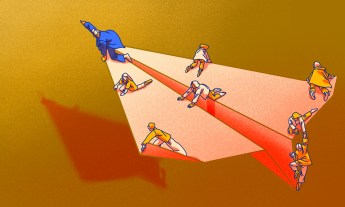
Making small tweaks to your meetings — even changing the seating! — can actually help set the stage for bigger shifts in our communities and companies, says social psychologist Dolly Chugh.
Many organizations and companies today track diversity in sex, gender, race, ethnicity, sexual orientation and religion, among other factors. For some of their leaders, numerical diversity is seen as the most important — and at times, the only — thing needed to create a varied and vibrant community. But by focusing on headcount, they are making the mistake of believing that diversity and inclusion are the same.
You can think of diversity as the gateways — to schools, communities, organizations — while inclusion includes the pathways that lead up to and through those gateways. Gateways include decision points such as admissions, hiring, promotions and salary decisions. Pathways are the moments that can shape those outcomes, but they tend not to be trackable by official statistics.
These are points on every pathway that can either trip a person up or send them in the right direction. For instance, in the academic world, one consequential moment is when prospective PhD students write to faculty members before applying to a doctoral program. These emails can lead to meaningful exchanges, contacts, mentoring and networking opportunities; sometimes, they can even influence admissions decisions or if a student is eventually selected by the professor to collaborate on research.
Some professors might receive hundreds of these emails a year, and each professor typically figures out how they want to handle them. I decided to conduct an experiment centered on this question: Does the responsiveness of professors vary depending on whether a prospective student is — or isn’t — a white male?
My team and I sent 6,500 emails to randomly selected professors from 259 US universities. The sender of the email was a fictional, out-of-town, prospective PhD student who expressed interest in the professor’s graduate program and sought his or her guidance. The emails were identical and impeccably written, varying only in the name of the senders, which included Meredith Roberts, Lamar Washington, Juanita Martinez, Raj Singh and Chang Huang. We used 20 different names in 10 different race-gender categories; some could be perceived as white and male, some could not. (Our study examined another issue related to the timing of the request, but for the findings reported here, the prospective student was requesting a meeting for the following week.)
Overall, 67 percent of the faculty members responded; of those, more than half agreed to meet with the fictional student. (As soon as the professor wrote back, we immediately canceled the meeting.) However, professors were more responsive to white males compared to other students in almost every discipline and across all types of universities and bias was most severe at private universities and in disciplines paying higher faculty salaries (with business showing the most bias). Even when the student and the faculty member shared a race or gender, we saw the same levels of bias. The only exception was Chinese students writing to Chinese professors; they received more responses. Nonetheless, Chinese students were the most discriminated-against group in our study.
This pathway is informal, unmeasured and fluid. The prospective applicants weren’t even at the gateway stage of applying, yet we found they were already at risk of bias. And in every world, there are particular pathways and moments that matter.
However, there are some pathways that are largely universal: meetings, listening and credit sharing. For organizations, meetings can serve as a microcosm for inclusion, replicating the group’s headwinds (challenges that make life harder for some people) and tailwinds (forces that make life easier for some). But meetings can also be important laboratories for change — controlled settings in which we make intentional tweaks that set the stage for bigger shifts. Here are 4 questions that can prompt you to examine bias at your organization and think about how you could create moments of inclusion.
Question #1: Who speaks at meetings?
Tony Prophet, the chief equality officer at Salesforce.com, likes to ask people to reflect about the last meeting they were in: “Who spoke? Who took the majority of the airtime? Who was checking their messages when a certain person was talking, and then started paying attention when someone else was talking? Who threw an idea at the table that wasn’t received as a great idea and then, 10 minutes later, who else put the same idea on the table and all of a sudden it’s an incredible idea? Who interrupted? Who was interrupted? Who did you not hear from? Who got invited to the meeting? Who didn’t get invited?”
I encourage you to use Tony’s questions as a starting point and observe the meetings in your own lives. You may find what researchers find: Women are more likely than men to be interrupted (by men and women). This disparity tends to occur in unstructured activities rather than in meetings or situations when people are assigned specific tasks. Power differences have an important role in who dominates the conversation — for men, that is. When men are in the high-power position in a meeting, they are likely to talk more, whereas women do not talk more even when they have more power.
Also, notice how expressions of anger and frustration are treated. Does everyone seem to have the same range of emotions available without judgment from others? Are passion and conviction received the same from everyone? What contributes to, or takes away from, psychological safety in the meeting?
Research suggests that you will probably notice patterns in your answers to these questions, so make observations at multiple meetings and then assess. What accounts for the similarities and differences? Ask a colleague to do the same, and compare notes with them. Often, we may not notice whose voices are missing or silent, but another person might see what we overlook (and vice versa).
Question #2: Who sits next to whom?
Meetings are not only about what is discussed but also about who interacts with whom. One way to redesign them is to simply adjust the seating. When Subha Barry led a wealth management practice at Merrill Lynch, she began thinking about how headwinds and tailwinds were being replicated in the process of how brokers interacted with clients. Certain prospective clients got lots of attention, and others did not. That wasn’t just bad for reasons of inclusion; it was also bad for business because opportunities were being missed.
At a lunch meeting with a group of clients and brokers, Barry decided to experiment. She sat one of her “white male, very Midwest brokers” next to an Indian doctor. “If I had not contrived the seating the way I did, they would not have sat next to each other,” she says. “By the end of the lunch, they had found so many things they had in common, I think they’d even made a golf date.”
Look at the seating in your meetings. Who sits in a seat that gives everyone a good view of him or her? Does the same person always sit in that seat? Do they need to? If you have influence over the seating, you could consider assigning seats — either with a particular purpose in mind or randomly. If you do not have influence over the seating — and even if you do — you can shake things up informally. Just sit next to someone different than usual or in a different part of the room. You may need to get to the room early to do this. If you’re worried about offending the people you usually sit with, give them advance warning. You could say, “I’ve noticed our meetings seem to go the same way each time. I thought it would be good for the group to keep things fresh, so I’m going to switch up where I sit. Are you up for doing the same?”
Question #3: Who is listened to?
Regardless of the type of meeting, listening is critical to inclusion. And, frankly, most of us are lousy listeners. We think faster than others speak, which creates the potential for significant mind wandering. Immediately after we hear someone speak, we’ve likely forgotten half of what they said, even when we were listening carefully. To make things worse, we listen to some people more than others.
Being a better listener can tune you in to whose voices are being discounted or muted. This kind of pathway bias is hard to measure and prove to others, so it is critical that we notice it when it happens (and listen to those who did notice, if we didn’t). Only then can we amplify those who are muted and include those who are excluded.
Some of my dissertation research looked at this issue. To do it, I walked up to strangers in the waiting area at a major train station in Boston and recruited them to participate in a study, where they had the chance to earn money for getting answers to difficult questions right. I chose questions that nobody could easily answer (e.g., guessing the number of jelly beans in a jar).
But my participants got some help — they were able to hear someone else’s answer, and they could use or discount the advice as they saw fit. Unbeknownst to them, I had rigged the game so all of the advice they heard was correct. The only variation was the voice behind it, which was male or female and sounded stereotypically “white,” “black” or “Hispanic.”
Who was listened to? It turns out that participants who were randomly assigned to a female or nonwhite adviser were less likely to take the advice offered. Without intending to, the game players (both male and female) essentially muted the female and minority voices. Now imagine how this could be playing out in your everyday life.
Question #4: Who gets the credit?
Credit sharing is a complicated matter. We tend to see ourselves as contributing more, and we also want to be seen as contributing more. Even ethical people tend to “round up” in their own favor. Studies of both collaborators and spouses show that individuals tend to claim excessive credit for their contributions to joint efforts. When a husband and wife are asked how much they contribute to the work of a household, researchers have found that the sum usually adds up to well over 100 percent.
In the workplace, men are also more likely to receive credit for their contributions to work than women. Frank Polley, a former Capitol Hill staffer, worries that the pattern goes beyond the normal human desire for credit. He remembered an instance where a female colleague did “the lion’s share of the work” on a project. Yet when the praise came in, he was thanked and she wasn’t even acknowledged. He confesses, “Looking back on it, I could have done a lot more to redirect the praise to where it was deserved. But I didn’t want to give up this moment of praise.”
Polley’s honesty reveals the challenge — overclaiming credit is something many of us do, and under-crediting people from groups facing bias is also something many of us do. Together, these two patterns are dangerous to inclusion. We don’t listen to the contributions from people around us, and then we claim their contributions as our own. This makes others less likely to listen to those people, and the pattern of exclusion goes on.
While pathway moments may seem relatively small — those moments when we feel like we’re more or less part of the meeting, when we’re more or less listened to, when we’re more or less credited for our work — they are the ones that help determine whether we’re given greater chances for success and effectiveness, or held back. We can all cultivate the capacity to notice failures of inclusion if and when they happen, and then try to do better going forward.
Excerpted from the new book The Person You Mean to Be: How Good People Fight Bias by Dolly Chugh. Reprinted with permission from Harper Business, an imprint of HarperCollins Publishers. Copyright © 2018 by Dolly Chugh.
Watch Dolly Chugh’s TED@BCG talk here:












